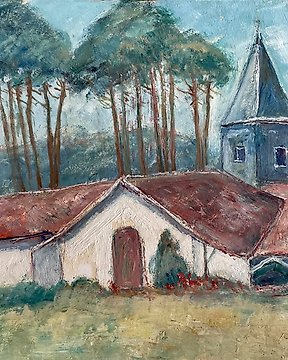
Jean-Roger Sourgen (1883-1978) - Church among the pines
Nr 85213371

Nr 85213371

Chana MORGENSZTERN (Chana ZYLBERMAN, dite)
Great artist to rediscover, style close to Chagall.
1913, Ostrow (Poland)- Paris 1991.
Self portrait 1973.
Mixted technique on paper.
Signed and dated.
Measurements: 65 x 50 cm.
Provenance:
- Collection Kupfer of jewish art.
Condition: good, see photos.
Chana Zylberman lived in the Parisian region of Occupied France. Chana took this portrait (see photo) on June 5, 1942 for the purpose of sending it to her interned fiancé Isaac Schönberg. Schönberg was a Polish painter and pianist, who had been in a French concentration camp since May 14, 1941. He wrote back to Chana on June 10, 1942 to commend her honest expression of a proud Jewish identity, saying: « I wasn’t wrong about you. I was sure that you would be among those who would wear the yellow star with pride. I did wonder if it might not bother you to pin it on before going to and from work; but I realized that [in wearing the star] you felt even stronger and freer than even I would have guessed. It filled me with such joy, and I’m so proud of you, and of the fact that our enemies are being eaten up by rage; those people who wanted to humiliate us and who thought that Jewish women and men would walk the streets, their heads hung in shame. It seems that these discriminatory, medieval laws will disappear as quickly as they appeared…They will pay dearly for all the physical and emotional suffering they have caused us. Let’s be strong and we will get through this terrible time, because deliverance is close at hand.
Isaac SCHONBERG (COLMAR, FRANCE 1907 – DEPORTED TO AUSCHWITZ 1942)
Isaac Schonberg’s parents were orthodox and originally came from a shtetl in Galicia. They fled anti-Semitic persecutions and settled in Colmar. Isaac attended the School of Fine Arts in Frankfurt and learned miniature painting. In 1934, he arrived in Paris and visited museums. He worked several small jobs; at night he played the piano at a bar, drew on silk ties and sold some stamps. He drew fine and precise drawings in pencil or pen while listening to Beethoven’s music. On May 14, 1941, Isaac Schonberg was arrested in Paris by the French police. He was interned in the Pithiviers camp and was deported on June 25, 1942 on convoy number 4. He was murdered in Auschwitz.
Nieszawer & Princ "Artistes juifs de l’Ecole de Paris 1905-1939" Editons Somogy 2015.
Exhibitions:
- 1983 : Ministère des Droits de la Femme. Paris.
- Centre national des arts plastiques, Paris. (permanent collection)
- Museum os Israel, Jerusalem. (permanent collection)
-Salon d'Automne
-Salon comparaison
- Salon des Artistes au Grand Palais
She is the Chana of the book lettres à Chana. Camp de pithiviers - 16 mai 1941-24 juin 1942 by Editions Cercil (1 may1995).
See also:
https://www.navigart.fr/fnac/artwork/chana-morgensztern-chana-zylberman-dite-veillee-de-sabbat-140000000014076
Hur du köper på Catawiki
1. Upptäck något speciellt
2. Lägg det högsta budet
3. Gör en säker betalning